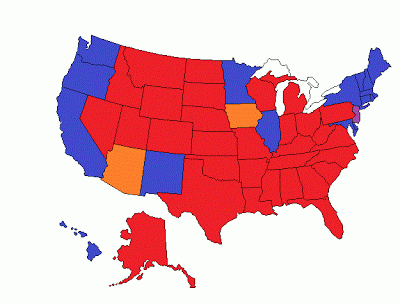The results of the presidential election are likely to be
extremely close, in both the Electoral Colleges and the popular vote. To become
president of the US you need a majority in the Electoral Colleges. The problem
here is that there are 538 college votes, which is an even number; so a tie is
at least theoretically possible.
It is unlikely that a tie will occur in 2012 but it is far
from impossible. Of the nine swing states, if Obama wins Wisconsin, Ohio and
New Hampshire whilst Romney wins Nevada, Iowa, Colorado, Virginia, North
Carolina and Florida then they both receive 269 votes and the race is tied.
So what happens next? Any normal person could reasonably
assume that you would defer to the popular vote! If you though that then you
would be wrong, instead a complex system kicks in where the presidency could be
temporarily be held by Joe Biden, Paul Ryan or even the Speaker of the House,
John Boehner.
When the race is tied, the House of Representatives gets to
decide who is President. You might expect that each of the 435 Representatives
gets one vote each – an odd number so no chance of a tie! Yet, once again, the
American electoral system departs from sanity. Instead of 435 Representatives
voting, they have to vote as 50 states. This is extremely disproportionate,
consider this; California has a population of 38 million people and has 53
Representatives, yet only gets one vote in a tie. On the other hand Wyoming has
a population of 560,000 people and has one Representative in the House, yet it
gets the same amount of votes as California in a tie. To make matters worse, 25
states have an even number of Representatives so the process could be slowed if
their internal voting is tied.
You might have thought that the insanity would stop there, but
you’d once again be wrong. So whilst the House picks the President, the Senate
gets to pick the Vice-President. This could result in the President being a
Republican and the Vice-President being a Democrat, or vice versa. Now, unlike
the House the Senate is already disproportionate in how seats are allocated;
every state gets two Senators regardless of population. This also causes more problems as there are
100 Senators, which means that there is (again) a risk of a tie. Great.
If the House is having trouble picking the President and the
Senate has already picked the Vice-President then he/she becomes acting
President. But if both branches of Congress are having trouble then the Speaker
of the House becomes acting President until someone gets chosen!
So how would things work out for this Presidential election?
To an outsider you would think that the elected members of congress would vote
for whoever won the most of the popular vote. To someone who has an
understanding of what American politics is like now, I wouldn’t be too sure.
Bi-partisanship is dead in America, particularly on the Republican side. In
primaries across the country incumbent Republicans were chucked out by the
party base in favour of those who promised to end compromise. This is most
notable in the case of Indiana Senator, Dick Lugar. The Republicans in Congress
are being held hostage by their base; a Republican would know that they risk
losing their party’s nomination if they were to vote for Obama: a man the
Republican base hate vociferously. If Romney wins the popular vote, I could see
some Democrats voting for Romney out of respect for democracy, but many would
vote against him.
So suddenly if becomes very important as to who wins
Congress. In the House it is highly likely that the Republicans will maintain
control and in the Senate it is likely that the Democrats will maintain
control. As each state gets one vote, individual congressional races become
very important on a Presidential scale! Polling is quite scarce for individual
House races, so it would be easy for some states to go either way. It’s easier
to predict the Senate as there are only 33 Senators up for election and polling
is more common for Senate races.
If we were to take the polls as definite for the House, then
you see Republicans having a majority of representatives from 31 states, the
Democrats taking a majority in 16 states, two states are impossible to tell and
one (New Jersey) is expected to be split.
 |
| Blue for Democratic Majority Red for Republican majority Orange for Tossup Purple for Tie |
In the Senate if we take the polls as definite and combine
them with the Senators not for re-election you would find a Democratic majority
of four or five. The following map indicates what it looks like (red for two Republican
Senators, blue for two Democratic Senators and Purple for states with one from
each party).
So if there is a tie, the House will likely vote for Mitt
Romney and the Senate for Joe Biden. That could make some interesting meetings…

No comments:
Post a Comment